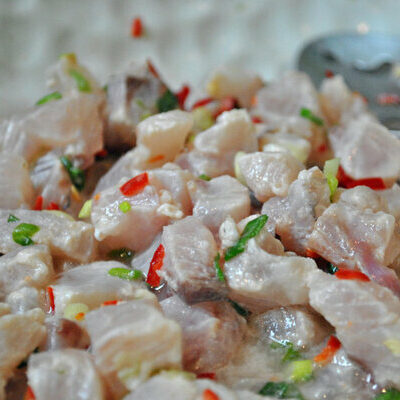
Fish Kinilaw
also known as Kinilaw na Isda
What is Fish Kinilaw?
Kinilaw is a Filipino cooking technique in which raw seafood is denatured using vinegar or citrus juice instead of cooking with heat. The acid in the vinegar or citrus will change the protein structure and make the food edible. Other than seafood, meat and vegetables may also be prepared using this technique. Fish kinilaw remains the most popular type of kinilaw in the Philippines.
- Usually, this dish is consumed as an appetizer or as a snack with alcohol.
- It has a mixture of tangy, sweet, and tart flavors.
The top 9 most popular Filipino appetizers are:
- Kinilaw
- Bola-Bola
- Inihaw na Liempo
- Tokneneng
- Kilawin
- Tokwa’t Baboy
- Camaron Rebosado
- Halabos na Hipon
- Crispy Tadyang ng Baka
Origin of kinilaw
Popular legend attributes the invention of the kinilaw to the Peruvian ceviche, which was imported into the Philippines through the Spanish colonizers. However, archaeological evidence points towards kinilaw being a 1000-year-old dish in the Philippines. Also, it is possible that Filipinos used tabon-tabon juice to marinate the fish. The first written reference to this dish was in the dictionary Vocabulario de la lengua Tagala of 1613, in which ‘cqilao’ is defined as a sort of pickling sauce of the natives, that is, salt, vinegar and chili in which meat or fish is placed.
Nutrition
Nutritional profile for fish kinilaw (1 serving):

Seafood and fish consumption provide essential polyunsaturated fatty acids, phospholipids, proteins, nitrogen compounds, taurine, fiber, phytosterols, and carotenoids. Regular consumption of seafood may assist in controlling obesity, improving brain function, decreasing blood cholesterol, increasing the bioavailability of proteins, reducing hypertension and oxidative stress, and stimulating blood clots. Additionally, it has antioxidant, anti-inflammatory, and anti-cancer properties.
Commercial production
To prepare fish kinilaw, only a few ingredients are required including fish, vinegar, spiced vinegar, onion, ginger, pepper, chili, sugar, tomato, and any citrus fruit. Of course, the fish chosen must be fresh. The most commonly used type of fish for fish kinilaw is tuna.
First, the fish is cubed and mixed with vinegar and set aside for a few minutes. After that, the vinegar is drained off to remove the fishy smell. Then, all the other ingredients are mixed and tossed until they blend. Finally, the fish kinilaw is refrigerated for a minimum of 30 minutes up to 3 hours.
Fish kinilaw recipes
This dish may have different variations but the basic ingredients remain the same. Here are a few recipes to try:
FDA regulations
Canned tuna is defined as food consisting of processed flesh of fish of the species packed in hermetically sealed containers and so processed by heat as to prevent spoilage. For the purpose of inhibiting the development of struvite crystals, sodium acid pyrophosphate may be added. The FDA does not currently have a standard of identity for fish kinilaw.
References
Hosomi, Ryota et al. “Seafood consumption and components for health.” Global journal of health science vol. 4,3 72-86. 28 Apr. 2012, doi:10.5539/gjhs.v4n3p72, https://www.ncbi.nlm.nih.gov/pmc/articles/PMC4776937/
Ninah Villa, Kinilaw History, Origin and Evolution – Into the Heart of Freshness, Pinoy Wit: Cultivating the Filipino Soul Through History and Culture, https://www.pinoywit.com/kinilaw-history-origin-evolution/
Johnston, Carol S, and Cindy A Gaas. “Vinegar: medicinal uses and antiglycemic effect.” MedGenMed : Medscape general medicine vol. 8,2 61. 30 May. 2006, https://www.ncbi.nlm.nih.gov/pmc/articles/PMC1785201/
Process Category Introduction, Food Safety and Inspection Service (FSIS), United States Department of Agriculture (USDA), https://www.fsis.usda.gov/wps/wcm/connect/71a3018b-5f77-46fe-bf78-b3f9cc4eb138/15_IM_Process_Category.pdf?MOD=AJPERES
